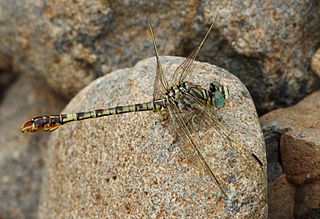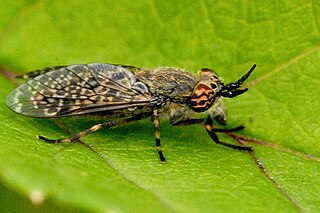
The Phoridae are a family of small, hump-backed flies resembling fruit flies. Phorid flies can often be identified by their escape habit of running rapidly across a surface rather than taking to the wing. This behaviour is a source of one of their alternate names, scuttle fly. Another vernacular name, coffin fly, refers to Conicera tibialis. About 4,000 species are known in 230 genera. The most well-known species is cosmopolitan Megaselia scalaris. At 0.4 mm in length, the world's smallest fly is the phorid Euryplatea nanaknihali.

Eumorpha pandorus, the Pandora sphinx moth or Pandorus sphinx moth, is a North American moth in the family Sphingidae. The species was first described by Jacob Hübner in 1821.

Platypezidae is a family of true flies of the superfamily Platypezoidea. The more than 250 species are found worldwide primarily in woodland habitats. A common name is flat-footed flies, but this is also used for the closely related Opetiidae which were included in the Platypezidae in former times.

Umbonia crassicornis, commonly known as the thorn bug, is a widespread member of the insect family Membracidae, and an occasional pest of ornamentals and fruit trees in southern Florida. The body length of the adult is approximately 10 millimetres (0.39 in). This is a variable species as to size, color and structure, particularly the pronotal horn of males. This tall, essentially perpendicular thorn-like pronotum discourages birds and other predators from eating it, if only by mistakenly confusing it with a thorn. Typically, the adult is green or yellow with reddish lines and brownish markings.

Crenigomphus hartmanni , the clubbed talontail, is a species of dragonfly in the family Gomphidae.

Nipponopsalididae is a family of harvestmen with three described species in one genus, Nipponopsalis, which is found in East Asia.

Oedemera nobilis, also known as the false oil beetle, thick-legged flower beetle or swollen-thighed beetle, is a beetle in the family Oedemeridae, a common species in Western Europe, including the south of England.

Symphoromyia is a genus of predatory snipe flies. Unusually for Rhagionids, some species of Symphoromyia are known to feed on mammal blood, including human blood. Symphoromyia species are stout bodied flies from 4.5 to 9 mm and with a black, grey or gold thorax, and the abdomen is coloured grey, black, or both black and yellow, black terminating with yellow, to completely yellow. The wings are hyaline or lightly infuscate.

Trithemis aurora, the crimson marsh glider, is a species of dragonfly in the family Libellulidae. It is a common and widely distributed species found throughout the year across the Indian subcontinent and Southeast Asia.
Cydia crassicornis is a moth of the family Tortricidae. It was first described by Lord Walsingham in 1907. It is endemic to the island of Hawaii.

Serrodes campana is a species of moth of the family Erebidae first described by Achille Guenée in 1852. It is found from the Indo-Australian tropics to eastern Australia, Fiji, Samoa and New Caledonia. It is also present in Japan, Korea and Sri Lanka. The adult is a fruit piercer, but also feeds on flower nectar.

Haematopota pluvialis, the Common Horse Fly or 'Notch-horned Cleg Fly', is a species belonging to the family Tabanidae subfamily Tabaninae.
Evagetes crassicornis is a kleptoparasitic spider wasp with a holarctic distribution.

Haematopota crassicornis, the Black-horned Cleg is a species in the horse-fly family, Tabanidae.
Campsicnemus popeye is a species of carnivorous fly described in 2013. It was discovered from the Society Islands in French Polynesia. The species is named after the famous cartoon character Popeye the Sailor Man because of the enlarged tibia. The species is in fact among a group of six new species described as "Popeye flies". The specimen was collected in 2006 during an expedition to Tahiti.

Ptiolina obscura is a species of 'snipe flies' belonging to the family Rhagionidae.
Symphoromyia cinerea is a species of snipe flies in the family Rhagionidae.

Symphoromyia immaculata is a Palearctic species of snipe fly in the family Rhagionidae.













